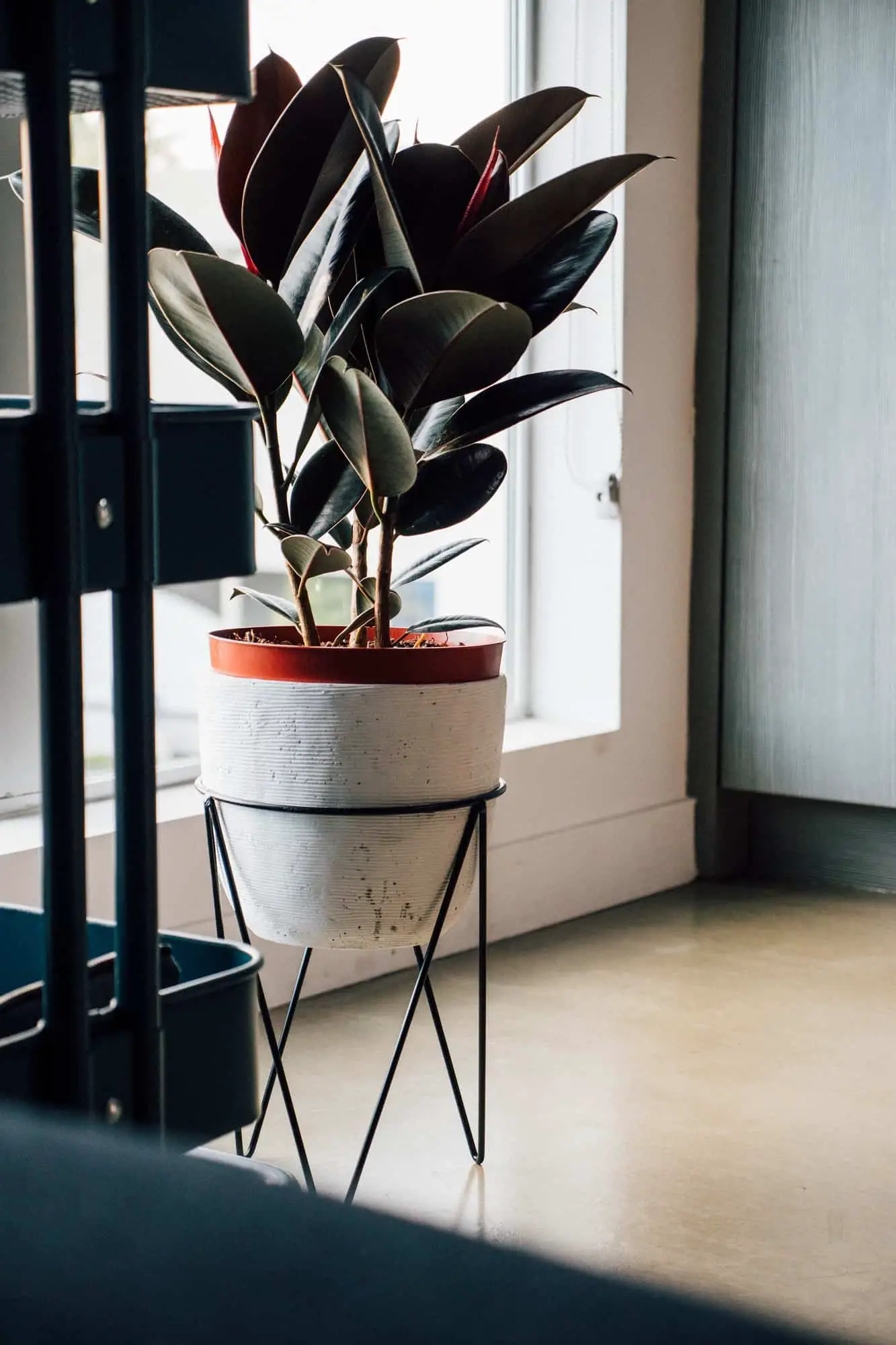Ficus Elastica, which is commonly known as Rubber Plant, is a popular ornamental houseplant due to its attractive appearance. This plant looks nice in brightly colored pots, and its glossy, dark leaves contrast well with the light-colored aesthetics. In addition, Rubber Plant is also a hardy plant that can thrive more easily than other plants in spaces with little light.
Rubber Plant is a hardy plant that can survive in low-light conditions. However, Rubber Plant should ideally be placed in a location that receives medium to bright, indirect light. In addition, Rubber Plant should be grown in well-draining soil, and the soil should be allowed to dry completely between watering sessions. Finally, fertilize Rubber Plant every 8 to 12 weeks with a slow-release fertilizer high in micronutrients.
The rest of this article will provide a brief description of the Rubber Plant and will outline how to care for Rubber Plant.
About Rubber Plant
Ficus Elastica, which is commonly known as Rubber Plant, Rubber Fig, or Indian Rubber Plant, is a species of plant native to Nepal, West China, and West Malesia. However, it has become naturalized in Sri Lanka, Florida, and the West Indies. It is well-known for its large, glossy leaves.
Rubber Plant is easy to grow and be kept in relatively low-light conditions. This makes them a great plant for bathrooms and kitchens. To read more about plants that can be grown well in bathroom environments, check out this article that I wrote.
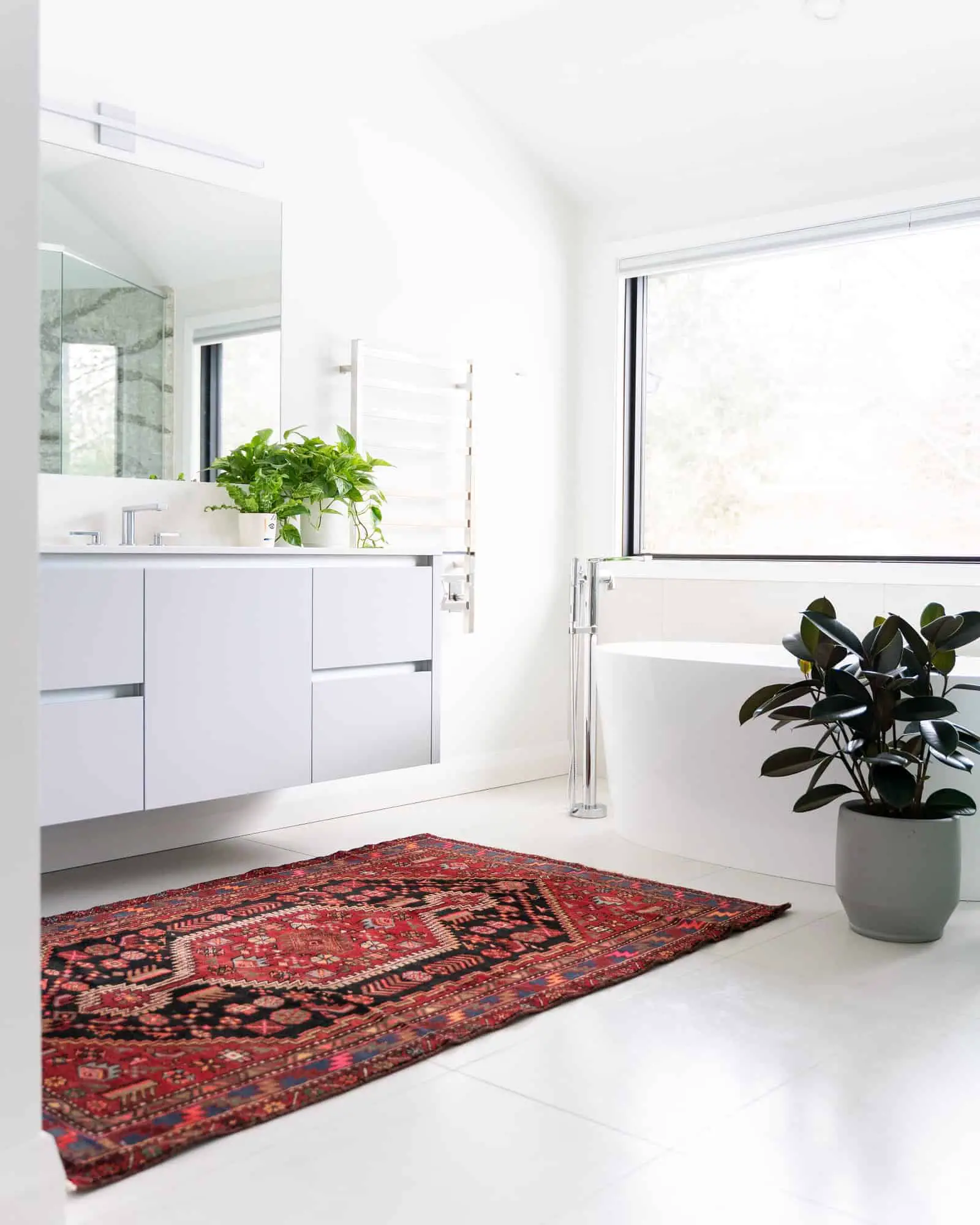
Despite its name, Rubber Plant is currently not a major source of rubber. All parts of the Rubber Plant produce a milky latex, and this substance was used to produce low-grade rubber during the early 1900s. However, the vast majority of the world’s latex comes from Rubber Tree (Hevea brasiliensis). The Rubber Tree belongs to a different family than the Rubber Plant.
These plants can also be grown outdoors within the United States Department of Agriculture (USDA) Hardiness Zones 10 and 11. When grown in suitable conditions, these plants can grow 40 to 100 feet tall. I have seen a few Rubber Trees near my house that have grown to a height between 40 to 50 feet tall. However, it seems like most people keep them as shrubs rather than trees.
Unfortunately, it is not uncommon for people to deface Rubber Plant leaves by carving graffiti into the dark leaves. Sap will drip or exude from the leaves. This sap can be toxic to pets or humans if ingested.
Varieties of Rubber Plant
There are several varieties of Rubber Plant available in the United States including Ficus Elastica decora (most common) and Ficus Elastica black prince. In addition, there are variegated varieties of Rubber Plant, but they can be difficult to find.
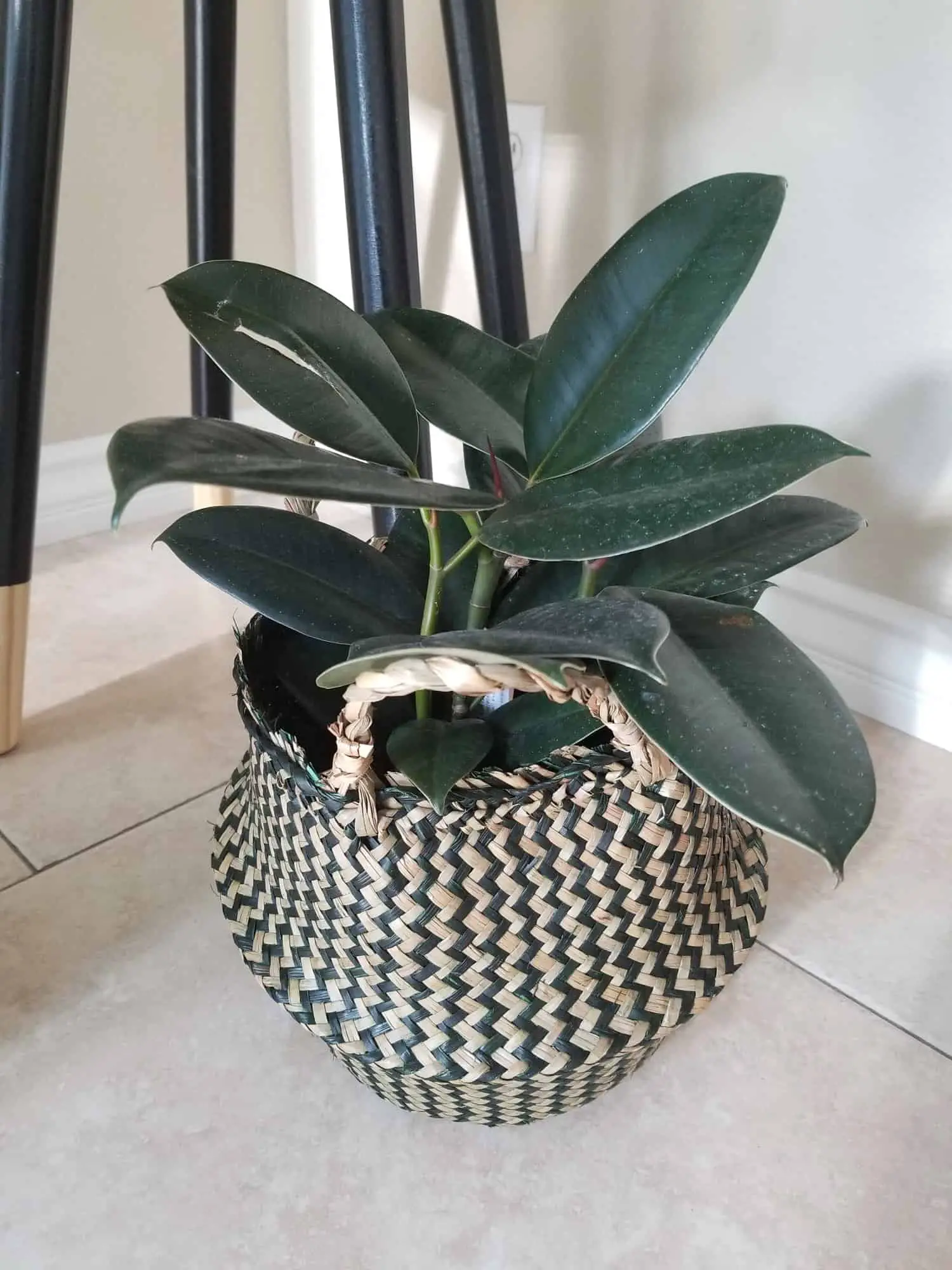
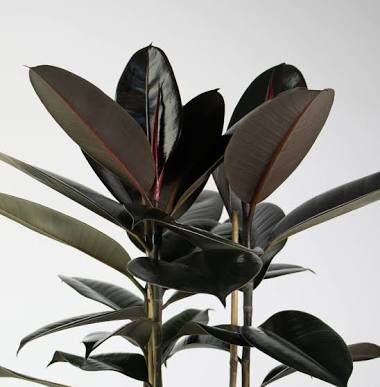

Rubber Plant Flowers
Rubber Plant is capable of producing flowers. The flowers are red sheaths and aretypically followed by the appearance of small fruits.
Like other plants belonging to the Ficus genus, a specific species of fig wasp is required to pollinate Rubber Plant. Because of this relationship, the Rubber Plant has never evolved to produce extremely fragrant or brightly colored flowers to attract pollinators.
It is unlikely that a Rubber Plant growing indoors will ever flower.
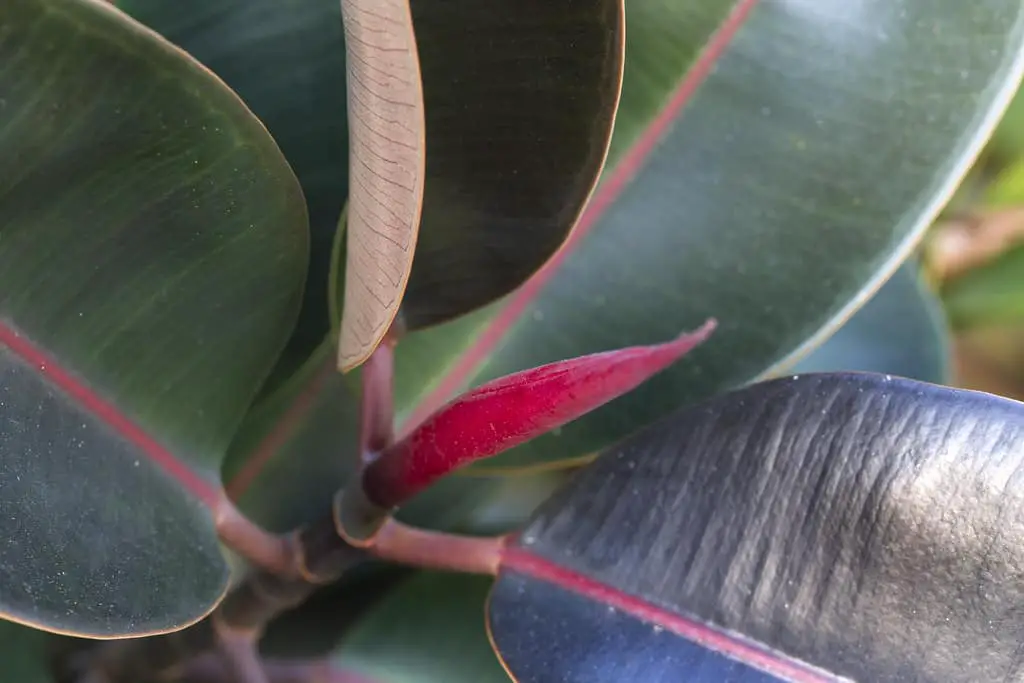
Lighting Requirements For Rubber Plant
Rubber Plant can survive in low-light conditions, but it grows best in medium to bright, indirect light. Too little light will result in the plant having a tall and lanky/stretched out appearance. However, too much exposure to direct, hot sunlight can scorch the leaves.
To ensure your Rubber Plant is receiving enough sunlight, it is also important to regularly clean the leaves in order to remove dust that may have accumulated on the surface of the leaf. Dust accumulation hinders the plant’s ability to absorb sunlight and photosynthesize properly.
Cleaning the leaves also improves the overall appearance of the Rubber Plant since dust seems to be more visible on burgundy leaves than green leaves.
Watering Rubber Plant
Properly watered Rubber Plants will maintain a healthy, waxy glow. The soak and dry method is an effective way to water Rubber Plant. This method involves thoroughly watering Rubber Plant until water is flowing out of the container’s drainage holes. Allow the soil to dry completely before watering again. In order to prevent the soil from being wet for too long, it is important to ensure your Rubber Plant is growing in well-draining soil.
Rubber Plant is fairly drought tolerant, so it is better to slightly underwater rather than overwater. Signs of underwatering include softer or droopy leaves. Rubber Plants can also lose their leaves if they are not watered properly.
These plants become dormant during the winter, so you only need to water them every once in a while during the winter months. Yellowing leaves are typically a sign that you are overwatering your Rubber Plant. This is especially true if the yellow/brown spots spread from the inner part of the leaf to the outer part of the leaf.
Soil Mix For Rubber Plant
Rubber Plant does not like “wet feet” meaning that it does not like for the soil to stay wet for too long. For this reason, it is important to place your Rubber Plant in well-draining soil. A soil mix that works well for houseplants is Al’s 5-1-1 soil mix. The ingredients are as follows:
- 5 parts pine bark,
- 1 part peat, and
- 1 part perlite.
Repotting Rubber Plant
Rubber Plants grow more quickly than many other species of indoor plants. As these plants grow taller and wider, they will require larger pots. Because Rubber Plants are trees, they do not like to grow potbound. Instead, they prefer more room to accommodate the roots.
Because Rubber Plant is a fast-growing plant, it may need to be transferred to a larger pot every year until they reach the desired size. Like other houseplants, Rubber Plant should be placed in pots that are one inch larger each time. Putting your Rubber Plant in a pot that is too much bigger than the root ball can cause the soil to remain wet too long which can result in root rot.
If your Rubber Plant is growing slowly or is still small, it may not need to be transferred to a new pot. In this case, you can simply scrape off an inch of topsoil and replace that soil with fresh potting soil or compost.
Fertilizing Rubber Plant
It is best to fertilize your Rubber Plant every 8 to 12 weeks with a slow-release fertilizer that is high in nitrogen. It is also important to apply a fertilizer that is high in micronutrients. In addition to the slow-release fertilizer, consider adding a 1/2 teaspoon of Epsom salts, which is magnesium sulfate, with a quart of water once or twice per year.
As with most species of houseplant, you should not fertilize Rubber Plant during the winter months. This is because the plant is not taking up as many nutrients during the winter months, so it can be easy to over-fertilize the plant.
Signs of over-fertilizing include a mineral crust on the soil surface or pot and yellowing of lower leaves. If you believe that your Rubber Plant has been over-fertilized, flush the soil or repot the plant in fresh soil.
Is Rubber Plant Toxic?
According to the American Society for the Prevention of Cruelty to Animals (ASPCA), Rubber Plant is toxic to cats and dogs if ingested. The sap that exudes from cut leaves can irritate skin and cause gastrointestinal issues if ingested.
The University of California Davis placed Rubber Plant in Toxicity Class 4, which means the sap of the plant can cause skin irritation. If you do get Rubber Plant sap on your skin, wash the affected area with soap and water. Call your doctor or the Poison Control Center if you believe that you are having an adverse reaction.
Related Questions
Why are leaves falling off of my Rubber Plant?
Rubber Plant will shed its leaves for a number of reasons including improper watering, too little light, or not enough humidity. To revive a stressed Rubber Plant, place it in a location that receives more light and consider purchasing a plant humidifier to increase the humidity. Finally, make sure that your plant is not growing in wet soil for extended periods of time.
Why are the leaves of my Rubber Plant turning yellow?
Yellow leaves or brown spots are typically a sign of underwatering or overwatering. Use your finger to check whether the soil is dry before watering. Rubber Plants should not be left dry for extended periods of time during the growing season (summer months).

